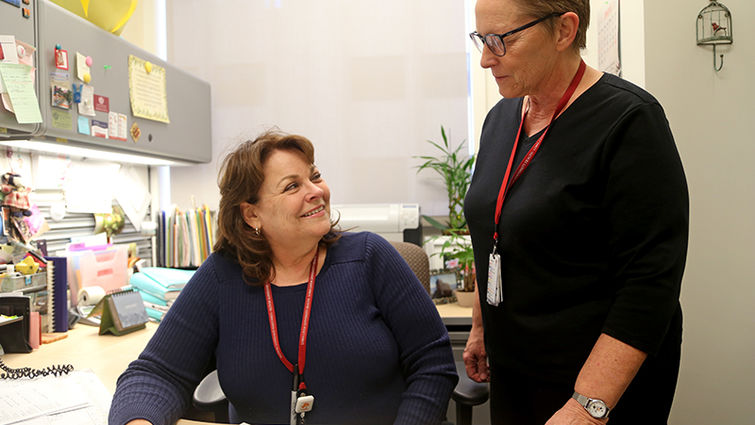
Candace Turner-Santacroce (left). manager of the Clinical Trials Unit at LLU Cancer Center, and Cyndee Pelton, clinical research coordinator, examine a patient chart.
Researchers at Loma Linda University Cancer Center (LLUCC) are seeking volunteers for clinical trials to determine if new medications or treatment regimens are effective against cancer.
Candance Turner-Santacroce, manager of the Clinical Trials Unit at LLUCC, says there are four types of clinical trials.
“In Phase I trials, the drug or treatment is tested to determine a safe dosage range and identify side effects,” she points out. “In Phase II, the drug or treatment modality is given to see if it is effective and to assess the side effects. Phase III trials confirm if the drug is effective, monitor side effects, and may compare the drug or procedure against standard treatment already established in order to verify whether it is more or less effective than the standard. Phase IV trials are done after the drug or treatment has been marketed to gather information on the drug’s effectiveness in various populations and any side effects associated with long term use.”
The number of participants in a particular clinical trial varies according to the phase involved. “Phase I trials usually only involve between 10 to 50 patients,” she reports. “Phase II trials enroll a larger number of patients, phase III trials enroll an even larger number of patients and may involve as many as 5,000 participants.
“Currently, we have 149 total clinical trials open here in the Cancer Center of which 89 are open for enrollment,” Turner-Santacroce notes. “We participate in studies sponsored by the National Cancer Institute through Southwest Oncology Group and the Children’s Oncology Group, pharmaceutical company sponsored trials, and trials initiated by our own physicians here at LLUCC. We have a team of coordinators who specialize in adult and pediatric oncology clinical trials. LLUCC conducts the largest number of oncology clinical trials in the Inland Empire."
She adds that clinical trials for non-cancer studies typically follow their subjects for a fixed duration, such as a 30-day period after the study treatment is complete. Oncology clinical trials, however, may follow patients for life in order to glean information about survival and quality of life.
In terms of how participants are recruited for the trials, Turner-Santacroce says most of them are patients already being seen in the Cancer Center.
“We also have patients who are referred to us from community physicians,” she acknowledges. Other participants learn about the studies online at www.ClinicalTrials.gov The site states that it “is a registry and results database of publicly and privately supported clinical studies of human participants conducted around the world.”
“Patients can access the web site,” Turner-Santacroce says, “to search their disease and find out where the clinical trials are being conducted for that disease. They then call to find out if they can participate and what they need to do. It is exciting as people are taking charge of their own treatment and this gives them a place to start.”
The website is offered as a service of the National Institutes of Health, and currently lists 233,074 studies at locations in all 50 states and in 195 countries.
